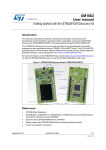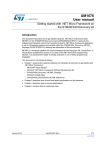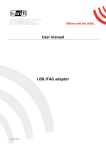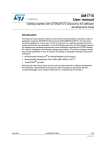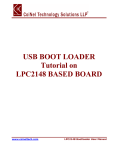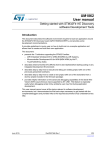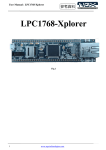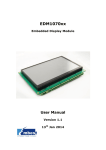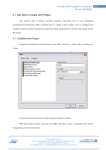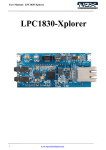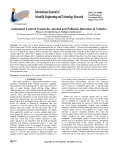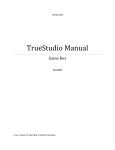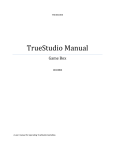Download UM1680 User manual - STMicroelectronics
Transcript
UM1680 User manual Getting started with STM32F429 Discovery software development tools Introduction This document describes the software environment and development recommendations required to build an application around the STM32F429 Discovery (32F429IDISCOVERY). It provides guidelines to novice users on how to build and run a sample application and to create and build their own application. This document is structured as follows: • Chapter 1 describes where to find the ST-LINK/V2 driver that should be installed before starting coding on any Integrated Development Environment • Chapter 2 describes step by step how to execute and debug an existing project with one of the following toolchains: – IAR Embedded Workbench® for ARM (EWARM) by IAR Systems – Microcontroller Development Kit for ARM (MDK-ARM) by Keil™ – TrueSTUDIO® by Atollic • Chapter 3 describes advanced debugging features • Chapter 4 provides links to detailed information on the previously mentioned toolchains Although this manual cannot cover all the topics relevant to software development environments; it demonstrates the first basic steps necessary to get started with the compilers/debuggers and provides links to the documents needed to fully understand every single step. October 2013 DocID025381 Rev 1 1/18 www.st.com Contents UM1680 Contents 1 2 System requirements . . . . . . . . . . . . . . . . . . . . . . . . . . . . . . . . . . . . . . . . 5 1.1 IDEs supporting STM32 family . . . . . . . . . . . . . . . . . . . . . . . . . . . . . . . . . . 6 1.2 ST-LINK/V2 installation and development . . . . . . . . . . . . . . . . . . . . . . . . . 6 1.3 Firmware package . . . . . . . . . . . . . . . . . . . . . . . . . . . . . . . . . . . . . . . . . . . 7 Executing / debugging firmware using software toolchains . . . . . . . . 8 2.1 EWARM toolchain . . . . . . . . . . . . . . . . . . . . . . . . . . . . . . . . . . . . . . . . . . . 8 2.2 MDK-ARM toolchain . . . . . . . . . . . . . . . . . . . . . . . . . . . . . . . . . . . . . . . . . 10 2.3 TrueSTUDIO toolchain . . . . . . . . . . . . . . . . . . . . . . . . . . . . . . . . . . . . . . . 12 3 STM32F429 advanced debugging . . . . . . . . . . . . . . . . . . . . . . . . . . . . . 15 4 SW Toolchains helpful references and links . . . . . . . . . . . . . . . . . . . . 16 5 Revision history . . . . . . . . . . . . . . . . . . . . . . . . . . . . . . . . . . . . . . . . . . . 17 2/18 DocID025381 Rev 1 UM1680 List of tables List of tables Table 1. Table 2. Table 3. Supported Toolchain versions . . . . . . . . . . . . . . . . . . . . . . . . . . . . . . . . . . . . . . . . . . . . . . . 6 IDE references . . . . . . . . . . . . . . . . . . . . . . . . . . . . . . . . . . . . . . . . . . . . . . . . . . . . . . . . . . 16 Document revision history . . . . . . . . . . . . . . . . . . . . . . . . . . . . . . . . . . . . . . . . . . . . . . . . . 17 DocID025381 Rev 1 3/18 3 List of figures UM1680 List of figures Figure 1. Figure 2. Figure 3. Figure 4. Figure 5. Figure 6. Figure 7. Figure 8. Figure 9. Figure 10. Figure 11. Figure 12. Figure 13. Figure 14. Figure 15. Figure 16. Figure 17. 4/18 Hardware environment . . . . . . . . . . . . . . . . . . . . . . . . . . . . . . . . . . . . . . . . . . . . . . . . . . . . . 5 Package contents . . . . . . . . . . . . . . . . . . . . . . . . . . . . . . . . . . . . . . . . . . . . . . . . . . . . . . . . . 7 IAR Embedded Workbench IDE . . . . . . . . . . . . . . . . . . . . . . . . . . . . . . . . . . . . . . . . . . . . . . 8 EWARM project successfully compiled. . . . . . . . . . . . . . . . . . . . . . . . . . . . . . . . . . . . . . . . . 8 Download and Debug button . . . . . . . . . . . . . . . . . . . . . . . . . . . . . . . . . . . . . . . . . . . . . . . . 9 IAR Embedded Workbench debugger screen . . . . . . . . . . . . . . . . . . . . . . . . . . . . . . . . . . . 9 Go button . . . . . . . . . . . . . . . . . . . . . . . . . . . . . . . . . . . . . . . . . . . . . . . . . . . . . . . . . . . . . . . 9 uVision4 IDE . . . . . . . . . . . . . . . . . . . . . . . . . . . . . . . . . . . . . . . . . . . . . . . . . . . . . . . . . . . . 10 MDK-ARM project successfully compiled . . . . . . . . . . . . . . . . . . . . . . . . . . . . . . . . . . . . . . 10 Start/Stop Debug Session button . . . . . . . . . . . . . . . . . . . . . . . . . . . . . . . . . . . . . . . . . . . . 11 MDK-ARM debugger screen. . . . . . . . . . . . . . . . . . . . . . . . . . . . . . . . . . . . . . . . . . . . . . . . 11 Run button . . . . . . . . . . . . . . . . . . . . . . . . . . . . . . . . . . . . . . . . . . . . . . . . . . . . . . . . . . . . . 11 TrueSTUDIO workspace launcher dialog box . . . . . . . . . . . . . . . . . . . . . . . . . . . . . . . . . . 12 Atollic TrueSTUDIO® import source select dialog box . . . . . . . . . . . . . . . . . . . . . . . . . . . . 12 Atollic TrueSTUDIO® import projects dialog box . . . . . . . . . . . . . . . . . . . . . . . . . . . . . . . . 13 TrueSTUDIO® project successfully compiled. . . . . . . . . . . . . . . . . . . . . . . . . . . . . . . . . . . 13 TrueSTUDIO debug window . . . . . . . . . . . . . . . . . . . . . . . . . . . . . . . . . . . . . . . . . . . . . . . . 14 DocID025381 Rev 1 UM1680 1 System requirements System requirements Before running your application, you should: 1. Install your preferred Integrated Development Environment (IDE). 2. Install the ST-LINK V2 driver from the ST web site. 3. Download the STM32F429I-Discovery firmware from the ST web site. 4. Establish the connection with the STM32F429 Discovery board as shown in Figure 1. Figure 1. Hardware environment To run and develop any firmware applications on your STM32F429 Discovery board, the minimum requirements are as follows: • Windows PC (2000, XP, Vista, 7) • 'USB type A to Mini-B' cable, to power the board (through USB connector CN1) from the host PC and connect to the embedded ST-LINK/V2 for debugging and programming. DocID025381 Rev 1 5/18 17 System requirements 1.1 UM1680 IDEs supporting STM32 family STMicroelectronics' STM32 family of 32-bit ARM Cortex-M core-based microcontrollers are supported by a complete range of software tools, encompassing traditional IDEs with C/C++ compilers and debuggers from major 3rd-parties (free versions up to 64KB of code, depending on partner), and completed with innovative tools from STMicroelectronics. Table 1 regroups general information about some IDE versions that officially support the STM32F429I product. Table 1. Supported Toolchain versions Toolchain Company Compiler Version Download link (*) EWARM www.iar.com/en/Products/IAR-Embedded-Workbench/ARM – 30-day evaluation edition 6.60 IAR Systems® IAR C/C++ and later – KickStart edition(32 KB Limitation for Cortex M3/M4) – KickStart edition(16 KB Limitation for Cortex M0) MDK-ARM Keil™ TrueSTUDIO © Atollic ARMCC www.keil.com/demo/eval/arm.htm 4.72 and later MDK-Lite (32 KB Code size limitation) GNUC www.atollic.com/index.php/request-eval-license(1) 4.1 – 32 KB Limitation (8 KB on Cortex-M0 and Cortex-M1) and later – 30 day Professional version (Trial) 1. Registration is required before download 1.2 ST-LINK/V2 installation and development The STM32F429 Discovery board includes an ST-LINK/V2 embedded debug tool interface which requires a dedicated USB driver. This driver is available on the www.st.com ST-LINK V2 page and is supported by these common software toolchains, and others: • • • IAR™ Embedded Workbench for ARM (EWARM) – The toolchain is installed by default on the PC's local hard disk in the C:\Program Files\IAR Systems\Embedded Workbench x.x directory. – After installing EWARM, install the ST-LINK/V2 driver by running ST-Link_V2_USB.exe from [IAR_install_directory]\embedded Workbench x.x \arm\drivers\ST-Link\ST-Link_V2_USBdriver.exe RealView Microcontroller Development Kit (MDK-ARM) toolchain – The toolchain is installed by default on the PC's local hard disk in the C:\Keil directory; the installer creates a start menu shortcut for µVision4. – When connecting the ST-LINK/V2 tool, the PC detects new hardware and asks to install the ST-LINK_V2_USB driver. The "Found New Hardware wizard" guides you through the steps needed to install the driver from the recommended location. Atollic TrueSTUDIO® STM32 – The toolchain is installed by default on the PC's local hard disk in the C:\Program Files\Atollic directory. – The ST-Link_V2_USB.exe is installed automatically with the software toolchain. Complementary information on the firmware package and the STM32F429 Discovery requirements are available from the Getting started with STM32 Firmware document. Note: 6/18 The embedded ST-LINK/V2 supports only SWD interface for STM32 devices. DocID025381 Rev 1 UM1680 1.3 System requirements Firmware package The STM32F429I-Discovery firmware applications, demonstration and IP examples are provided in one package in one zip file. Extracting the zip file generates one folder, STM32F429I-Discovery_FW_VX.Y.Z, which contains the following subfolders: Figure 2. Package contents Template project: Pre-configured project with empty main function to be customized by you. This is helpful to start creating your own application based on the peripherals drivers. Master workspace: Assembly of all projects available within this firmware package. Peripheral examples: Set of examples for each peripheral ready to be run. DocID025381 Rev 1 7/18 17 Executing / debugging firmware using software toolchains 2 Executing / debugging firmware using software toolchains 2.1 EWARM toolchain UM1680 The following procedure compiles, links and executes an existing EWARM project. The steps below can be applied to an existing example, demonstration or template project for STM32F429I-Discovery_FW_VX.Y.Z firmware available at www.st.com. 1. Read the firmware readme.txt file which contains the firmware description and hardware/software requirements, then start the EWARM toolchain. Figure 3 shows the basic names of the windows referred to in this document. Figure 3. IAR Embedded Workbench IDE 2. Select File > Open > Workspace. Browse to select either an example, demonstration or template workspace file and click Open to launch it in the Project window. 3. Select Project > Rebuild All to compile your project. If your project is successfully compiled, the following window is displayed. Figure 4. EWARM project successfully compiled 8/18 DocID025381 Rev 1 UM1680 Executing / debugging firmware using software toolchains If you need to change project settings (Include and preprocessor defines), just go through project options: 4. – For Include directories: Project>Options…>C/C++ compiler> – For pre-processor defines: Project>Options…C/C++ compiler>pre-processor> Select Project > Download and Debug or, alternatively, click the Download and Debug button the in toolbar, to program the Flash memory and begin debugging. Figure 5. Download and Debug button 5. The debugger in the IAR Embedded Workbench can debug source code at C and assembly levels, set breakpoints, monitor individual variables and watch events during code execution. Figure 6. IAR Embedded Workbench debugger screen 6. Select Debug > Go to run your application, or click the Go button in the toolbar. Figure 7. Go button DocID025381 Rev 1 9/18 17 Executing / debugging firmware using software toolchains 2.2 UM1680 MDK-ARM toolchain The following procedure compiles, links and executes an existing MDK-ARM project. The steps below can be applied to an existing example, demonstration or template project for STM32F429I-Discovery_FW_VX.Y.Z firmware available at www.st.com. 1. Open Keil MDK-ARM Microcontroller Kit. Figure 8 shows the basic names of the "Keil uVision4"windows referred to in this document. Figure 8. uVision4 IDE 2. Select Project > Open Project... Browse to select either an example, demonstration or template project file and click Open to launch it in the Project window. 3. Select Project > Rebuild All target files to compile your project. If your project is successfully compiled, the following window is displayed. Figure 9. MDK-ARM project successfully compiled You can change your project settings (Include and preprocessor defines), through the project options: 4. 10/18 – For Include directories: Project>Options for Target > C/C++ > Include Paths – For pre-processor defines: Project>Options for Target > C/C++ > Preprocessor symbols > Define Select Debug > Start/Stop Debug Session or, click the Start/Stop Debug Session button in the toolbar, to program the Flash memory and begin debugging. DocID025381 Rev 1 UM1680 Executing / debugging firmware using software toolchains Figure 10. Start/Stop Debug Session button 5. The MDK-ARM debugger can debug source code at C and assembly levels, set breakpoints, monitor individual variables and watch events during code execution. Figure 11. MDK-ARM debugger screen 6. Select Debug > Run to run your application, or click the Run button in the toolbar. Figure 12. Run button DocID025381 Rev 1 11/18 17 Executing / debugging firmware using software toolchains 2.3 UM1680 TrueSTUDIO toolchain The following procedure compiles, links and executes an existing TrueSTUDIO project. The steps below can be applied to an existing example, demonstration or template project for STM32F429I-Discovery_FW_VX.Y.Z firmware available at www.st.com. 1. Open Atollic TrueSTUDIO for ARM. The program launches and asks for a Workspace location. Figure 13. TrueSTUDIO workspace launcher dialog box 2. Browse to select a TrueSTUDIO workspace of either an example, demonstration or template workspace file and click OK to load it. 3. To load an existing project in the selected workspace, select File > Import, then General > Existing Projects into Workspace and click Next. Figure 14. Atollic TrueSTUDIO® import source select dialog box 12/18 DocID025381 Rev 1 UM1680 Executing / debugging firmware using software toolchains 4. Click Select root directory and browse to TrueSTUDIO workspace folder. Figure 15. Atollic TrueSTUDIO® import projects dialog box 5. In the Projects panel, select the project and click Finish. 6. In the Project Explorer, select the project, open Project menu, and click Build Project. 7. If your project is successfully compiled, the following messages will be displayed on the Console window. Figure 16. TrueSTUDIO® project successfully compiled DocID025381 Rev 1 13/18 17 Executing / debugging firmware using software toolchains UM1680 To change the project settings (Include directories and preprocessor defines), just go through Project>Properties, select C/C++ Build>Settings from the left panel: 8. – For Include directories: C Compiler>Directories>Include path – For pre-processor defines: C Compiler>Symbols> Defined symbols To debug and run the application, select the project in the Project Explorer and press F11 to start a debug session (see Figure 17). Figure 17. TrueSTUDIO debug window 9. The debugger in the Atollic TrueSTUDIO can debug source code at C and assembly levels, set breakpoints, monitor individual variables and watch events during code execution. 10. Select Run > Resume to run your application, or alternatively click the Resume button in the toolbar. 14/18 DocID025381 Rev 1 UM1680 3 STM32F429 advanced debugging STM32F429 advanced debugging The STM32 family using the Cortex-M4 processor has many interrupts and it can be difficult to determine when they are being activated and how often. Serial Wire Viewer (SWV) on the STM32F429 family makes this task easy. In fact, SWV displays PC Samples, Exceptions (including interrupts), data reads and writes, ITM (printf), CPU counters and a timestamp. This information comes from the ARM CoreSight™ debug module integrated into STM32F429 CPU. SWV does not steal any CPU cycles and is non-intrusive (except for ITM Debug printf Viewer). You have already configured Serial Wire Viewer (SWV) on the template project. This allows: 1. Retargeting printf to ITM stimulus port(0). This allows debug messages to display easily. How to use it: EWARM : View > terminal IO MDK-ARM : View > Serial Windows Debug (printf) Viewer TrueSTUDIO: View > SWV Console 2. Exception trace: Entry: when the exception enters. Exit: When it exits or returns. Return: When all the exceptions have returned to the main EWARM : ST-LINK > Interrupt log MDK-ARM : View > Trace > Exceptions TrueSTUDIO: View > SWV Exception Trace Log 3. Function profiler: Shows timing information for the functions in an application EWARM : ST-LINK > Function Profiler MDK-ARM : View > Analysis Window > Code Coverage TrueSTUDIO: View > SWV Statistical Profiling 4. Data Trace Timeline: Shows a graphical representation of the data EWARM : ST-LINK > Timeline (Data log) MDK-ARM : View > Analysis Window > Logic Analyzer TrueSTUDIO: View > SWV Data Trace Timeline DocID025381 Rev 1 15/18 17 SW Toolchains helpful references and links 4 UM1680 SW Toolchains helpful references and links The following table regroups useful references about the integrated development environments described in this document: Table 2. IDE references Toolchain 16/18 Download link EWARM www.iar.com/en/Products/IAR-Embedded-Workbench/ARM/ EWARM_UserGuide MDK-ARM www.keil.com/demo/eval/arm.htm www.keil.com/arm/mdk.asp TrueSTUDIO www.atollic.com/index.php/request-eval-license DocID025381 Rev 1 UM1680 5 Revision history Revision history Table 3. Document revision history Date Revision 26-Oct-2013 1 Changes Initial release. DocID025381 Rev 1 17/18 17 UM1680 Please Read Carefully: Information in this document is provided solely in connection with ST products. STMicroelectronics NV and its subsidiaries (“ST”) reserve the right to make changes, corrections, modifications or improvements, to this document, and the products and services described herein at any time, without notice. All ST products are sold pursuant to ST’s terms and conditions of sale. Purchasers are solely responsible for the choice, selection and use of the ST products and services described herein, and ST assumes no liability whatsoever relating to the choice, selection or use of the ST products and services described herein. No license, express or implied, by estoppel or otherwise, to any intellectual property rights is granted under this document. If any part of this document refers to any third party products or services it shall not be deemed a license grant by ST for the use of such third party products or services, or any intellectual property contained therein or considered as a warranty covering the use in any manner whatsoever of such third party products or services or any intellectual property contained therein. UNLESS OTHERWISE SET FORTH IN ST’S TERMS AND CONDITIONS OF SALE ST DISCLAIMS ANY EXPRESS OR IMPLIED WARRANTY WITH RESPECT TO THE USE AND/OR SALE OF ST PRODUCTS INCLUDING WITHOUT LIMITATION IMPLIED WARRANTIES OF MERCHANTABILITY, FITNESS FOR A PARTICULAR PURPOSE (AND THEIR EQUIVALENTS UNDER THE LAWS OF ANY JURISDICTION), OR INFRINGEMENT OF ANY PATENT, COPYRIGHT OR OTHER INTELLECTUAL PROPERTY RIGHT. ST PRODUCTS ARE NOT DESIGNED OR AUTHORIZED FOR USE IN: (A) SAFETY CRITICAL APPLICATIONS SUCH AS LIFE SUPPORTING, ACTIVE IMPLANTED DEVICES OR SYSTEMS WITH PRODUCT FUNCTIONAL SAFETY REQUIREMENTS; (B) AERONAUTIC APPLICATIONS; (C) AUTOMOTIVE APPLICATIONS OR ENVIRONMENTS, AND/OR (D) AEROSPACE APPLICATIONS OR ENVIRONMENTS. WHERE ST PRODUCTS ARE NOT DESIGNED FOR SUCH USE, THE PURCHASER SHALL USE PRODUCTS AT PURCHASER’S SOLE RISK, EVEN IF ST HAS BEEN INFORMED IN WRITING OF SUCH USAGE, UNLESS A PRODUCT IS EXPRESSLY DESIGNATED BY ST AS BEING INTENDED FOR “AUTOMOTIVE, AUTOMOTIVE SAFETY OR MEDICAL” INDUSTRY DOMAINS ACCORDING TO ST PRODUCT DESIGN SPECIFICATIONS. PRODUCTS FORMALLY ESCC, QML OR JAN QUALIFIED ARE DEEMED SUITABLE FOR USE IN AEROSPACE BY THE CORRESPONDING GOVERNMENTAL AGENCY. Resale of ST products with provisions different from the statements and/or technical features set forth in this document shall immediately void any warranty granted by ST for the ST product or service described herein and shall not create or extend in any manner whatsoever, any liability of ST. ST and the ST logo are trademarks or registered trademarks of ST in various countries. Information in this document supersedes and replaces all information previously supplied. The ST logo is a registered trademark of STMicroelectronics. All other names are the property of their respective owners. © 2013 STMicroelectronics - All rights reserved STMicroelectronics group of companies Australia - Belgium - Brazil - Canada - China - Czech Republic - Finland - France - Germany - Hong Kong - India - Israel - Italy - Japan Malaysia - Malta - Morocco - Philippines - Singapore - Spain - Sweden - Switzerland - United Kingdom - United States of America www.st.com 18/18 DocID025381 Rev 1


















